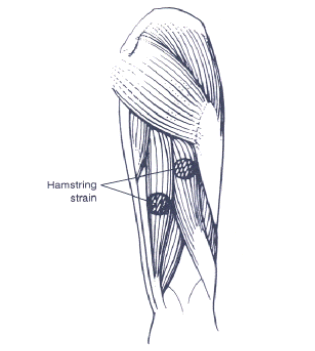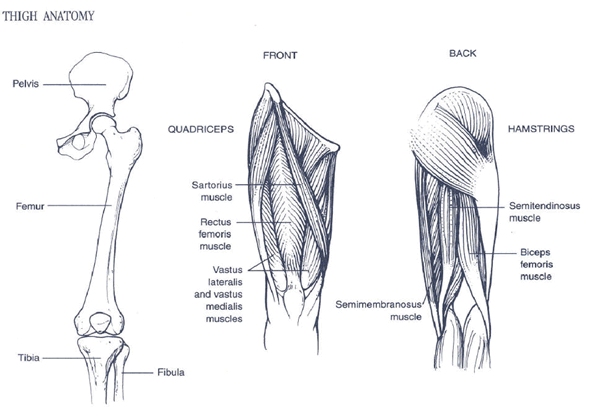Avoid
Hamstring Strains like the plague
perform static stretching
with 30-second stretch-holds
hours away from performance
A hamstring strain is a slight tear of one or more of the three muscles behind the thigh.
It is one of the most common injuries in sports, and one of the most debilitating. The likelihood of a hamstring strain is dramatically increased if the muscles are not warmed up and seem to target two main areas where the hamstring is the weakest.
Common injury points

Hamstring strains are difficult to treat and take time to rehab. It is essential not to return to sprinting too soon, as reinjury is likely.
Symptoms
A violent contraction of the hamstring muscles when the athlete increases speed - or digging in hard.
First degree: athlete feels a slight "pull" in the muscles behind the thigh while sprinting but is able to continue the activity. The next day the muscle may be sore, but it does not inhibit walking or slow jogging, and there is no difficulty performing straight-leg raises.
Second degree: athlete feels a "twinge" while sprinting. The muscle is tender, and bruising is noticeable. Bending the knee and jogging are also difficult.
Third degree: While sprinting the athlete collapses. Walking is very difficult and the athlete can't place weight on the injured leg. Crutches may be required for one to two weeks.
Athletes at risk
Those engaged in sports that require explosive stop-start running motions and activities that place extreme stretching demands on the hamstrings, such as gymnastics. The likelihood of a hamstring strain is increased if the athlete is tight and does not warm up properly.
When injured
Self-treat with Rest & ICE as soon as possible after the injury occurs and continue for 48 hours. Some coaches have athletes wear a neoprene thigh sleeve upon returning to practice.
What the doctor can do:
If the injury is a second- or third-degree strain, the doctor may also provide the athlete with crutches or recommend bedrest. Crutches are usually discontinued when the athlete can walk without a limp.
If the injury is a third-degree strain, treatment may include rehab exercises.
During Healing
Scarring in the muscle usually takes place after a strain, gentle stretching exercises should be done as soon as possible after an injury to minimize the scarring. This is important because scarring makes the muscle less flexible, and this increases the chance of reinjury.
After a first-degree strain, gentle stretching should begin the day after the injury, if pain allows. These stretching exercises are described under the level one rehabilitation exercises. Level two exercises to develop both strength and flexibility in the muscle should start three to five days after a first-degree strain.
In the case of a second- or third-degree strain, level one stretching and strengthening exercises should begin within one to two weeks of the injury and progress accordingly.
When all tenderness is gone and the hamstring can be tensed fully without pain, the athlete can begin running training in conjunction with rehabilitation exercises. Start with slow jogging for twenty to thirty minutes, then perform stretching exercises for the hamstrings, then do half- to three-quarter-speed sprints over 50 to 75 yards. Explosive bursts of speed should be avoided. When sprinting can be done without pain at a three-quarters pace, full-speed sprinting can be attempted. If the athlete experiences any pain during or after any of these running activities, he or she should cut back on running intensity. During the sprinting training, it is advisable to wear a thigh sleeve that keeps the muscle warm and also acts as a support for the muscle.
Recovery time
First-degree strain: one to two weeks.
Second-degree strain: three to four weeks.
Third-degree strain: up to ten weeks.
The Sports
Medicine Bible by Lyle J. Micheli, M.D.. This chapter of the book also
includes sections titled "Thigh Injury Rehabilitation" and "Conditioning
Program For The Thigh".

